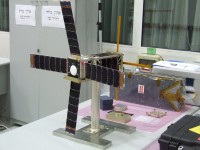These days the association is checking various launch options, with the intention of launching the satellite in the second half of 2011

The Israel Nano Satellite Association announced at the Ilan Ramon Space Conference the completion of the construction of the first Israeli nanosatellite, Inlkajn-1. In the next four months, the satellite will undergo a series of tests that include vibration and shock experiments, vacuum experiments and a functional test in space conditions of all the sub-systems integrated in it.
These days the association is checking various launch options, with the intention of launching the satellite in the second half of 2011.
The satellite is named after the Israeli space pioneer Dr. Marcel Klein. It is planned to move in a solar orbit (helio-synchronous) at an altitude of about 650 km and circle the earth every 90 minutes. Unlike other satellites, it does not contain navigation engines, and its stability will be controlled using three magneto-turkers.
The Inlkajn-1 satellite has two main missions: a space mission and a ground mission.
The space mission: Space Open Laboratory for technological experiments:
• Passive orientation in space:
The satellite includes 4 solar panels spread out in a star configuration and with an internal inclination angle of 10 °. The angle means that at any given moment there are differences in the density of the radiation flux from the sun on each of the panels. Measuring these differences will allow the satellite to always locate the direction of the sun, without the need for expensive dedicated equipment.
• Material durability test in space conditions:
The satellite will perform volatility experiments of materials for the space industry developed by MMG. The materials were painted over some of the solar cells. The rate and intensity of their evaporation will affect the amount of energy absorbed by the solar panels. In fact, Inlkajn-1 is the first satellite to generate more energy from the sun as its stay in space lengthens.
• Testing a new space battery:
The satellite will test the function and characteristics of a new battery based on 4 lithium-ion batteries manufactured by ABSL.
• Testing GPS navigation equipment:
The satellite will test the functionality and resistance to space conditions of a GPS receiver developed in Israel by the Rokar-BEA company.
• Atomic clock test:
The satellite will test its function in space conditions of a new atomic clock developed by the Israeli company Accubeat, which plans to use it to enter the global space market.
Experiment with modulation methods:
The satellite will test, in cooperation with the Association of Radio Amateurs in Israel, the advantages and disadvantages of the FSK and BPSK digital modulation methods for telemetry systems in space.
About 70% of malfunctions in space components are in components whose size is smaller than 10 cm. Inlkajn-1 provides an available and inexpensive platform for testing space components and obtaining Space Prove certifications.
The mission of the land is educational: INSA operates several educational projects.
• The association assisted in the establishment of the space laboratory at the Herzliya Science Center. The assistance includes lectures for students, accompanying students and professional assistance in setting up the infrastructure.
• Satellite reception station Inlkajn-1 satellite management and control station, was established at the Herzliya Science Center and will be operated by the center's students.
• The INSA association assisted in establishing a clean room for assembling pico satellites and unique technological equipment, and accompanying the Israel Student Pico Satellite project, Duchifat-1.
• About a year ago, the center's students won the German Embassy prize as part of a competition for young scientists in Israel. The award was given for a project to test and characterize the antennas of the Inlkajn-1 satellite.
• The space major at the Science Center currently includes about 300 students. Of these, 40 students participate in space projects related to Inlkajn-1 and receive a matriculation grade of 5 units in technology engineering for them.
• In the month of February, two national courses that INSA delivers to middle school and high school students will open in the scope of 48 hours on the subjects of space engineering and satellites.
• These days, talks are being held between INSA and the Department of Education in the city of Modi'in, which asked the association for assistance in establishing a field of space studies in the city.
Main technical characteristics of Inlkajn-1:
• Cubesat's 3U platform.
• Dimensions: 10x10x32 cm.
• Weight: 3.5 kg, including the experimental probes with a total weight of 1.5 kg.
• 4 central sensing and control systems: triaxial magnetometer, triaxial gyroscope, solar cells for sun detection, 3 magneto-turkers for controlling the inclination angle in relation to the Earth's magnetic field.
• 2 system computers: a 430-bit MSP16-based computer from TI, and a 3-bit LEON32-based computer from Aeroflex Gaisler.
• Corner Reflector for locating a location using the SLR (Satellite Laser Ranging) technique.
• A communication system based on a standard radio amateur radio made by Alinco that was converted for a space mission and a radio made by ISIS.
• Transponder for providing communication services to radio amateurs around the world and a beacon signal that will be received all over the world and sent to the control station via the Internet.
• Communication, telemetry and command will be carried out at amateur radio frequencies in the VHF (downlink) and UHF (uplink) fields, using the AFSK (Audio Frequency-Shift Keying) and BPSK (Binary Phase-Shift Keying) digital modulation methods.
The first Israeli nanosatellite, Inklajn-1, in the assembly room
1D design of the first Israeli nanosatellite, Inklajn-XNUMX
